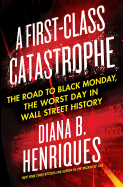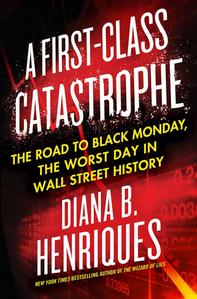
 Reading Diana B. Henriques's A First-Class Catastrophe: The Road to Black Monday, the Worst Day in Wall Street History could be a revelation to younger readers used to thinking of the 2008 financial crisis as the signature market crash of modern times. Henriques brings readers' attention back to October 19, 1987--dubbed "Black Monday"--when the Dow Jones Industrial Average fell a shocking 22.6%, "still the largest one-day decline in Wall Street history. That was the equivalent of an urgent midafternoon news flash today screaming, 'DOW FALLS NEARLY 5,000 POINTS!'" The book is a reminder that the 2008 meltdown was not unprecedented, and that the disaster might have been avoided altogether if market leaders and government officials had learned the right lessons from the 1987 crash.
Reading Diana B. Henriques's A First-Class Catastrophe: The Road to Black Monday, the Worst Day in Wall Street History could be a revelation to younger readers used to thinking of the 2008 financial crisis as the signature market crash of modern times. Henriques brings readers' attention back to October 19, 1987--dubbed "Black Monday"--when the Dow Jones Industrial Average fell a shocking 22.6%, "still the largest one-day decline in Wall Street history. That was the equivalent of an urgent midafternoon news flash today screaming, 'DOW FALLS NEARLY 5,000 POINTS!'" The book is a reminder that the 2008 meltdown was not unprecedented, and that the disaster might have been avoided altogether if market leaders and government officials had learned the right lessons from the 1987 crash.
Similarly, Black Monday followed on the heels of numerous smaller crises that should have set off warning bells with traders and regulators. Financial journalist Henriques (The Wizard of Lies) tracks these mini-crises, showing, for example, that in 1980 a couple of silver-hoarding billionaire brothers very nearly set off "a series of domino defaults," and that in 1982 an overextended lender in Oklahoma almost cratered the banking industry. The tally of crises might become wearying were it not for Henriques's patient guidance, enlivening the story with entertaining anecdotes and sketches of the various characters involved in the unfolding financial drama.
Behind the scenes, these crises were caused or exacerbated by a confluence of market and regulatory failures. Theories about "rational markets" prompted deregulation in the Reagan era, leading in turn to rapid financial innovations with unforeseen consequences. Meanwhile, stock exchanges upgraded to the digital era, relying more and more on lightning-fast computer trading as giant institutional investors started to dominate the markets. In an increasingly volatile market, newly created "portfolio insurance" offered by a couple of Berkeley academics seemed like a perfect opportunity for companies to hedge their bets. This, too, would have consequences, but regulators were often too busy managing their meager budgets or fighting time-consuming turf wars between agencies to provide proper oversight.
Henriques has a low-key style, favoring patient explanation over moral outrage. Still, her account subtly undermines the concept of rational markets--"human beings do not cope well in a crisis when speed, complexity, secrecy, and fear all batter our emotions at the same time"--while also making the case for pragmatic responses to financial crises. Referring to the controversial question of whether to bail out big banks while letting smaller ones fail, Henriques writes: "If a bunch of small retention ponds are leaking and there is a rapidly growing crack in the Hoover Dam, you shore up the Hoover Dam." Her account is not hopeful, as might be expected from a book about a major crisis that "if it was remembered at all, was recalled as the crash without consequences." A First-Class Catastrophe capably punctures that myth, along with many more dangerous truisms that continue to proliferate in political and financial circles. --Hank Stephenson, bookseller, Flyleaf Books, Chapel Hill, N.C.
Shelf Talker: A First-Class Catastrophe provides a cogent history of the events leading up to and following the 1987 Black Monday stock market crash, reflecting on its connections to the 2008 financial crisis and continued relevance.

